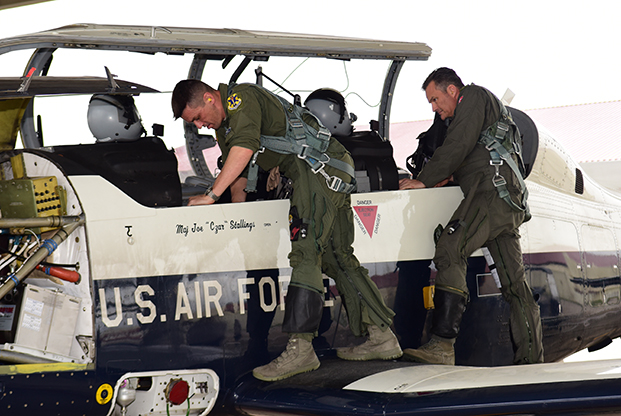
The T-6 Texan II's oxygen system is slated for a redesign in response to a USAF study into hypoxia-like symptoms reported by pilots. Air Force photo by Randy Martin.
The Air Force plans to redesign the oxygen system in its T-6 Texan II and adjust oxygen control levels in flight, after an exhaustive study determined that varying levels of oxygen concentrations were to blame for the hypoxia-like symptoms reported by pilots.
The service grounded its primary trainer fleet earlier this year while it inspected the Onboard Oxygen Generation System (OBOGS) on all T-6 aircraft, and it stood up an independent review team to determination potential causes.
“So far, technical efforts to date and analysis of data collected have determined that pilots have been exposed to significantly changing levels of oxygen concentration,” said Lt. Gen. Steven Kwast, AETC commander. “The varying levels of oxygen concentration, even though in excess of what the body typically needs, has caused physiological stress that most pilots, on most days, actually adapt to without noticing.” However, the physiological stress of the changing oxygen levels can cause some pilots to experience symptom similar to hypoxia (lack of oxygen), hypocapnea (lack of carbon dioxide), and other related conditions, said Kwast in a press release issued late Thursday.
It is expected to take two to four years to redesign the OBOGS system and fully stabilize oxygen levels in the T-6, a joint effort between Air Education and Training Command and Air Force Materiel Command. The two major commands also are working with industry “to adjust the OBOGS software algorithm to stabilize oxygen concentrations,” according to the release.
“While this should reduce physiological events, the Air Force will pursue a broader redesign,” states the release.
The Air Force and the Navy also have worked together to come up with new maintenance procedures to ensure the OBOGS system operates more efficiently. And, AETC will provide additional training for pilots to help them identify such symptoms and then learn how best to react if they ever encounter them in flight.
“Since our T-6 operational pause, we have made every effort to communicate with every instructor and every student exactly what we’ve found,” Maj. Gen. Patrick Doherty, 19th Air Force commander, said. “Transparency remains of utmost importance to use as we all work together to ensure that our pilots are safe and know the way ahead.”